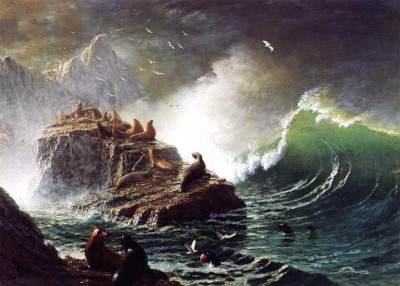The artist travelled out to the Farallon Islands in the early 1870s in order to find new sources of inspiration for his work. Some of the highlights to appear from that body of work included Seals on the Rocks, Farallon Islands, which we see in front of us here.
These rocky islands sit in the gulf of the Farallones, just off the coast of San Francisco in California, United States. The artist would travel all across America during his career in search of different ideas for his work, but California features particularly frequently across his oeuvre. The decision to travel to these islands was something unusual, however, as normally he would travel by land and follow the routes of major rivers in order to discover new and exciting environments. It is likely that he was already aware of certain aspects of the islands themselves, as they are famous for wildlife and this combined with some dramatic geology makes it an exciting place to visit for any artist, both then and still very much the case today. One can find an abundance of seals, seabirds, whales and sharks here, offering Bierstadt a wealth of aesthetic and compositional opportunities for his work. Besides this painting, the artist also created Seal Rocks, Farallones from the same visit.
The artist creates a very dramatic scene here which perhaps underlines the influence on his style from several German painters, such as members of the Dusseldorf School who often liked to really produce an element of drama within their landscapes. We see a pivotal moment here where seals are gathered upon a rockface just as a huge wave enters the scene from the right hand side and approaches them menacingly. In the foreground we see some birds flying off to safety and in the far distance are several mountains which help to layer the perspective. It is likely that the artist would have created much of this drama himself, and that the original scene that he witnessed may not have been quite as precarious as that which we see here, which was a method that some approved of, and some not.
In terms of related artworks, the artist produced many other paintings across California during his lifetime, including the likes of California Spring and also Looking Down Yosemite Valley, California. He would also travel to Europe as well in order to find other environments that interested him, and was European by birth himself, having moved to the US from Germany as a two year old. He became interested in local people in each of these different regions, be it Italians, Swiss or the native Indians who he sometimes came across within the US. He also visited Canada too, which feels an obvious choice considering the artistic genre in which he worked. Normally he would sit and sketch whilst in these locations before then turning his favourite ideas into large scale paintings once he had returned to the comfort of his own studio. He quickly learnt which items would sell and predominantly targeted the domestic market for those interested but unable to travel to some of these stunning locations.




